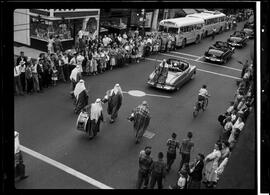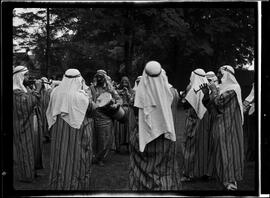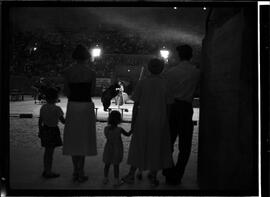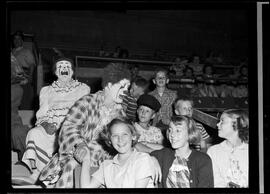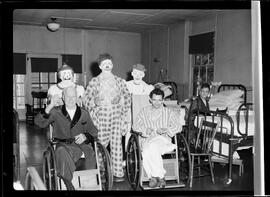Title and statement of responsibility area
Title proper
Shriner's Circus
General material designation
- Graphic material
Parallel title
Other title information
Title statements of responsibility
Title notes
- Source of title proper: Title supplied by Kitchener-Waterloo Record staff.
Level of description
File
Reference code
Edition area
Edition statement
Edition statement of responsibility
Class of material specific details area
Statement of scale (cartographic)
Statement of projection (cartographic)
Statement of coordinates (cartographic)
Statement of scale (architectural)
Issuing jurisdiction and denomination (philatelic)
Dates of creation area
Date(s)
Physical description area
Physical description
6 photographs : b&w negatives ; 8 x 10 cm
Publisher's series area
Title proper of publisher's series
Parallel titles of publisher's series
Other title information of publisher's series
Statement of responsibility relating to publisher's series
Numbering within publisher's series
Note on publisher's series
Archival description area
Name of creator
Biographical history
The Kitchener-Waterloo Record began with the publication of the Daily News of Berlin on February 9, 1878 and was the first daily paper in the area. It was published by Peter Moyer. Over the years it had several names and publishers: in January of 1897 it was purchased by the German Printing and Publishing Company and was amalgamated with that company's Berlin Daily Record to become the Berlin News Record, and later still the News Record, all published by William (Ben) V. Uttley. In 1918 the publishers of the German-language paper the Berliner Journal, William D. Euler (later Senator for North Waterloo) and William J. Motz, purchased the News Record and changed the name to the Kitchener Daily Record. On July 17, 1922 the Record absorbed the other daily, the Daily Telegraph. With that event, the original three daily papers (the News Record, the Berlin Daily Record, and the Daily Telegraph) became one.
The Berliner Journal began in December 29, 1859 by Frederick Rittinger and John Motz, and was located on Queen Street south, Kitchener. Motz remained editor until his death in 1899, at which time his son William acquired his father's interest. When Rittinger died in 1915 his share was acquired by William D. Euler. The weekly Journal ended on May 10, 1924. The Record’s first staff photographer was Harry Huehnergard, who worked for the paper for 49 years before retiring in 1986 as Manager of the Photographic Department.
In 1948 the Kitchener Daily Record was re-named the Kitchener-Waterloo Record, which name it retained until 1994, when it became simply The Record. In 1928 the paper moved from its home at 49 King Street west to a new building at 30 Queen Street north where it was to stay for 44 years until moving in May 1973 to 225 Fairway Road. When William J. Motz died in 1946 his son John E. Motz took over as publisher. The by-then Senator Euler sold his interest to Southam Press in 1953. John E. Motz died in 1975 and the Motz Family continued to own a controlling interest in the paper until 1990, when it was sold to Southam. In 1998, The Record was sold to Sun Media Corporation, and then in March 1999, to Torstar Corporation. In January 2005, the paper moved its offices to Market Square on King Street east in Kitchener's downtown core, and on March 11, 2008, the name was changed to the Waterloo Region Record.
Custodial history
Scope and content
Notes area
Physical condition
Immediate source of acquisition
Arrangement
Language of material
Script of material
Location of originals
Availability of other formats
Envelope scanned as TIF files September 2019.
Restrictions on access
Terms governing use, reproduction, and publication
Public Domain
Finding aids
Associated materials
Accruals
General note
51-3124_006 and 51-3124_007 appeared on Page 3 of the Friday, June 29, 1951 edition of the newspaper as part of the article: "Circus Artists Bring Joy to Hospital Patients."
General note
Photo caption from published version of 51-3124_006: "CIRCUS AT HOSPITAL - Two acts from the Shrine-Circus [sic] yesterday visited the Knollwood Park Hospital, which cares for many aged patients. The clowning trio shown above brought smiles and joyful shouts to a roomful of aged and invalid patients."
General note
Photo caption from published version of 51-3124_007: "DOGS PERFORM - Sponsored by the Waterloo County Shrine Club and aided by the Waterloo Women's Hospital Auxiliary the circus visit to the Knollwood Park Hospital was a treat for patients. Left to right after the performance are Mrs. Elmer Gillard, chairman of the Waterloo Auxiliary visiting committee, Mrs. Frank Musselman, president, Ernie Kirk and Miss Bea Adams, with their trained dogs; Allan Bowman, president of the Waterloo County Shrine Club; Charles Bascelle, manager of the circus, and Frank Musselman, secretary of the Shrine Club."
General note
51-3124_005 and a photo missing from envelope appeared on Page 3 of the Thursday, June 28, 1951 edition of the newspaper as part of the article: "Shrine Circus Lives Up to Its Reputation."
General note
Photo caption from published version of 51-3124_005: "CIRCUS JOYS - The thrill of the circus was experienced yesterday afternoon by about 3,000 boys and girls but none were more thrilled than the group above when the clowns came to frolic. Many crippled children were in the audience as guests of the circus sponsors."
General note
Photo caption from missing photo [see 51-3124_002 for closest version]: "SHRINERS ON PARADE - The Rameses Oriental Band of Hamilton, one of four bands in the Shrine parade last night, shown above, performed during the intermission of the evening performance of the circus."
General note
“Crippled” is an outdated and pejorative term used historically to refer to individuals with a physical disability. The use of the term in the file title has been maintained in keeping with Special Collections & Archives’ approach to language in archival descriptions, which prioritizes speaking openly about and clearly identifying problematic, harmful, and otherwise offensive records in the department’s holdings. This approach, while potentially upsetting, allows for the critical assessment and questioning of historical material by contemporary researchers.


